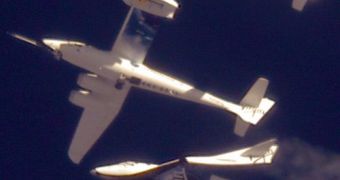Officials at Virgin Galactic announced that their SpaceShipTwo suborbital space plane managed to carry out its first successful solo test flight yesterday, October 10.
The flight, which saw the aircraft being released by its WhiteKnightTwo carrier, took place above the California-based Mojave Air and Space Port.
Thought the SpaceShipTwo is designed to reach suborbital altitudes, it did not aim to reach the edge of space during these test flights.
The goal was to analyze the aircraft's gliding capabilities. After separating from its carrier, it spent more than 15 minutes gliding until it managed to land safely at the spaceport.
“It was perfect landing. It looked just spectacular,” says eyewitness Bill Deaver, quoted by Space. The SpaceShipTwo is controlled by two pilots, an can carry several passengers.
The spacecraft, whose development is funded by UK billionaire Sir Richard Branson, is called the VSS Enterprise, and it is being operated by Virgin Galactic.
The company plans to construct a small fleet using this type of aircraft, which will provide passengers willing to pay a $200,000 price tag with the chance of seeing the Earth from the edge of space.
Virgin Galactic says that more than 340 people have already signed up on its waiting lists, for seats on the first flights. This amount of orders hints at just how lucrative the private space industry may become.
“The two main goals of the flight were to carry out a clean release of the spaceship from its mothership and for the pilots to free fly and glide back and land at Mojave Air and Space Port in California,” a press release from Virgin states.
Some of the other goals for the new tests include successful separation from the mother ship, testing all systems related to the undocking, evaluation of handling and stall characteristics.
The team also assessed the qualitative evaluation of stability and control for the spacecraft. Experts then compared the data to statistical predictions, computer simulations, and design data.
The lift-to-drag ratio of the aircraft during glide flight was also measured with precision, Space reports.
“Now, our challenge going forward will be to complete our experimental program, obtain our FAA license and safely bring the system into service at Spaceport America, New Mexico,” says George Whitesides.
The official is the chief executive officer of Virgin Galactic. Also present for the test flights was the founder of Virgin Group, Sir Richard Branson.
“This was one of the most exciting days in the whole history of Virgin,” he said.
“For the first time since we seriously began the project in 2004, I watched the world's first manned commercial spaceship landing on the runway at Mojave Air and Space Port and it was a great moment,” Branson added.
“Now, the sky is no longer the limit and we will begin the process of pushing beyond to the final frontier of space itself over the next year,” he concluded.

 14 DAY TRIAL //
14 DAY TRIAL //